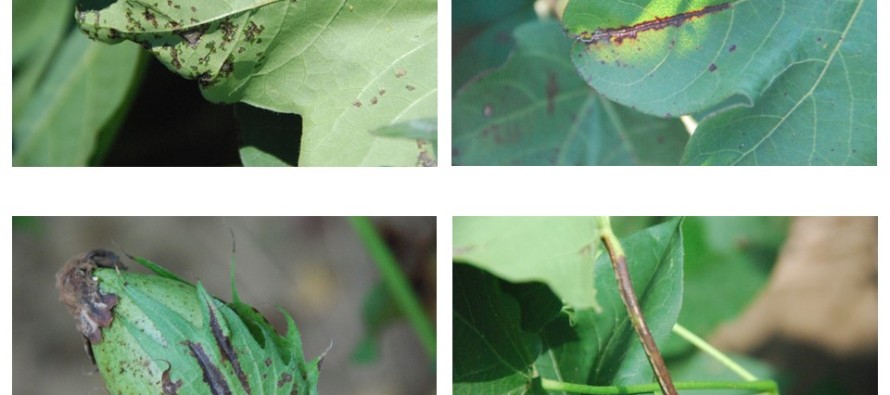Scouting Cotton for Bacterial Blight in 2014

 Since 2011, bacterial blight of cotton has become an almost annual occurrence. However, to our knowledge only light bacterial blight was observed during the 2013 season. The bacterial blight that occurred during the 2011 and 2012 seasons in MS resulted in substantial yield losses in some fields of susceptible cotton varieties. At present, a single variety has been observed to be exhibiting symptoms in several locations throughout MS. Geographically, bacterial blight has been observed in the north and south Delta as well as east MS. The majority of the cotton varieties planted in MS are susceptible to bacterial blight. Trials conducted during 2011 determined that five of the 22 varieties in the OVT trials were resistant to bacterial blight including Deltapine 1133, Fibermax 1740, Fibermax 9058, Phytogen 375, and Stoneville 5288. For more information on whether or not specific varieties are susceptible to bacterial blight refer to:
Since 2011, bacterial blight of cotton has become an almost annual occurrence. However, to our knowledge only light bacterial blight was observed during the 2013 season. The bacterial blight that occurred during the 2011 and 2012 seasons in MS resulted in substantial yield losses in some fields of susceptible cotton varieties. At present, a single variety has been observed to be exhibiting symptoms in several locations throughout MS. Geographically, bacterial blight has been observed in the north and south Delta as well as east MS. The majority of the cotton varieties planted in MS are susceptible to bacterial blight. Trials conducted during 2011 determined that five of the 22 varieties in the OVT trials were resistant to bacterial blight including Deltapine 1133, Fibermax 1740, Fibermax 9058, Phytogen 375, and Stoneville 5288. For more information on whether or not specific varieties are susceptible to bacterial blight refer to:
More often than not, bacterial blight will begin in the lower canopy and move up the plant. However, the bacterium responsible for the disease normally does not favor sunlight and therefore will remain in the lower part of the canopy since the environment is more favorable. Bracts, bolls, petioles, stems, and leaves can all exhibit symptoms of bacterial blight. However, the appearance of the disease on plant parts differs. When scouting for the disease, factor in the appearance of bacterial blight on different plant parts. If you think you’ve identified blight on leaf tissue as the small angular leaf spots between the veins, continue to scout for some of the other symptoms to verify the presence of the disease.

Bacterial blight of cotton can produce several different symptoms on plant parts. Leaves, bracts and petioles all can exhibit symptoms of the disease.
Symptom expression on individual plant parts
Leaves – lesions on leaves appear as small, angular spots that in some cases can congregate around the veins. The angular nature of the spots are produced by the capillary veins limiting the spread of the bacterium within leaf tissues. Be mindful that the angular appearance of the lesions can be confused with other diseases as well as herbicide injury. By flipping the leaf over (see associated image), and observing the underside of the leaf the water-soaking around the spot will develop a greasy appearance, especially in the presence of morning dew. However, if you’re having trouble determining bacterial blight from other diseases (or even herbicide injury) look for two specific characteristics: 1) a systemic vein infection (see image), generally in the mid to upper canopy and 2) the appearance of extreme water-soaking around lesions that may congregate on leaf tissues.
Bracts – lesions on bracts look more elongated than on leaves and are generally brown to maroon in color.
Bolls – the easiest symptom to observe and determine that you have bacterial blight would be the presence of the small, water-soaked lesions on bolls (see: http://www.mississippi-crops.com/2011/07/21/update-bacterial-blight-of-cotton/). Lesions on bolls will go from having a round water-soaked appearance to a dark, black appearance when the lesions are most mature. At present, bolls have not been formed in the fields where the disease has been observed.
Petioles – the “black-arm phase” of the disease can occur on petioles and can be confused with herbicide injury. Dark-colored, ashen lesions generally surround the entire petiole.
Management alternatives
Once identified, no management practices are warranted since the disease is caused by a bacterium. Don’t alter your management practices for the rest of the season just because you encounter bacterial blight in a field of susceptible cotton. Most of the cotton varieties we plant are not only susceptible to the disease, but can compensate to infection. In addition, even though humidity can increase the disease do not stop irrigating fields even though in overhead irrigated situations this can act to increase the disease through simulated rain splash. Fungicides are not a viable alternative since they do not have an effect on bacteria.



